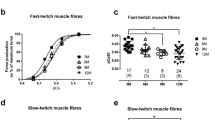Summary
-
1.
Muscle properties of rat strains showing different locomotor activities were studied. The isometric contraction times (CT) of the slow soleus muscle are shorter in both young and adult domesticated Wistar than in wild brown rats; no difference was found in the fast extensor digitorum longus (EDL) muscles. No significant difference was seen with respect to half relaxation time (HRT) in either fast or slow muscles. CT and HRT of the diaphragm are longer in young brown rats than in domesticated animals, while the diaphragm of the adult wild rat differs only by a longer HRT.
-
2.
Histochemically, the fast EDL muscle and diaphragm show different types of muscle fibres, i.e. fibres with low and high myofibrillar ATPase activity (type I and II), and fibres with low, intermediate and high succinic dehydrogenase (SDH) activity (type A, B and C). The EDL and diaphragm of brown rats have a higher percentage of “fast-red” fibres with high ATPase and SDH activities (type II C) and phospholipid content, than the Wistar rats. The slow soleus muscles of young and adult brown rats are uniform with respect to low ATPase activity and heterogeneous with respect to SDH activity; in the Wistar rat the soleus muscles are heterogeneous with respect to both myosin ATPase and SDH activities, i.e. they contain “slow-intermediate” (I B) and “fast-red” (II C) fibres. The pattern of phospholipid content is similar to the SDH pattern in each case. No difference was found in phosphorylase activity. The glycogen content is higher in both fast and slow muscles of the adult rat than in the muscles of the domesticated rat.
Similar content being viewed by others
References
Altman, P.L., Dittmer, D.S. (eds): Biology data book. Biological Handbooks. Washington: Federation of American Society for Experimental Biology 1964
Barnard, R.J., Edgerton, V.R., Peter, J.B.: Effect of exercise on skeletal muscle. I. Biochemical and histochemical properties. J. appl. Physiol.28, 762–766 (1970a)
Barnard, R.J., Edgerton, V.R., Peter, J.B.: Effect of exercise on skeletal muscle. II. Contractile properties. J. appl. Physiol.28, 767–770 (1970b)
Bass, A., Gutmann, E., Melichna, J., Syrovy, I.: Contractile and enzymatic properties of fast and slow muscles of rabbit and hare. Physiol Bohemoslov.22, 477–486 (1973)
Close, R.I.: Dynamic properties of mammalian skeletal muscles. Physiol. Rev.52, 129–197 (1972)
Elleder, M., Lojda, Z.: Studies in lipid histochemistry. XI. New, rapid, simple and selective method for the demonstration of phospholipids. Histochemie36, 149–166 (1973)
Engel, W.K.: The essentiality of histo- and cytochemical studies of skeletal muscle in the investigation of neuromuscular disease. Neurology12, 778–794 (1962)
Faulkner, J.A., Maxwell, L.G., Brook, D.A., Lieberman, D.A.: Adaptation of guinea pig plantaris muscle fibres to endurance training. Amer. J. Physiol.221, 291–297 (1971)
Guth, L., Samaha, F.J.: Procedure for the histochemical demonstration of actomyosin ATPase. Exp. Neurol.28, 365–367 (1970)
Gutmann, E., Hájek, I.: Differential reaction of muscle to excessive use in compensatory hypertrophy and increased phasic activity. Physiol. Bohemoslov.20, 205–212 (1971)
Gutmann, E., Melichna, J.: Contractile properties of different skeletal muscles of the rat during development. Physiol. Bohemoslov.21, 1–7 (1972)
Gutmann, E., Melichna, J.: Syrový, I.: Developmental changes in contraction time, myosin properties and fibre pattern of fast and slow skeletal muscles. Physiol. Bohemoslov.23, 19–27 (1974)
Holloszy, J.O.: Adaptation of skeletal muscle to endurance exercise. Med. Sci. Sports7, 155–164 (1975)
Jeffress, R.N., Peter, J.B., Lamb, D.R.: Effects of exercise on glycogen synthetase in red and white skeletal muscle. Life Sci.7, 957–960 (1968)
Karpati, G., Engel, W.K.: Neuronal trophic function. A new aspect demonstrated histochemically in developing soleus muscle. Arch. Neurol.17, 542–545 (1967)
Klicpera, M., Žák, R., Drahota, Z.: Notes on the determination of muscle glycogen. Čs. Fyziol.6, 544–547 (1957) (In Czech)
Kugelberg, E.: Adaptive transformation of rat soleus motor units during growth—histochemistry and contraction speed. J. Neurol. Sci.27, 269–289 (1976)
Martin, W.D., Romond, E.H.: Effects of chronic rotation and hypergravity on muscle fibers of soleus and plantaris muscles of the rat. Exp. Neurol.49, 758–771 (1975)
Melichna, J.: A contribution to questions concerning the regulation of contractile and histochemical properties of skeletal muscles (In Czech). Thesis, Physiological Institute of Czechoslovak Academy of Sciences, Prague (1976)
Nachlas, M.M., Tsou, K., De Souza, E., Cheng, C., Seligman, A.M.: Cytochemical demonstration of succinic dehydrogenase by the use of a new p-nitrophenyl substituted ditetrazole. J. Histochem. Cytochem.5, 420–436 (1957)
Rohlíček, V.: An automatic analyzer of muscle contraction. Tech. Digest.61, 383–387 (1968)
Sandow, A., Brust, M.: Contractility of dystrophic mouse muscle. Amer. J. Physiol.194, 557–561 (1958)
Staudte, H.W., Exner, G.U., Pette, D.: Effects of short-term, high intensity (sprint) training on some contractile and metabolic characteristics of fast and slow muscle of the rat. Pflügers Arch. ges. Physiol.344, 159–168 (1973)
Stein, J.M., Padykula, H.A.: Histochemical classification of individual skeletal muscle fibres of the rat. Amer. J. Anat.110, 103–123 (1962)
Syrový, I., Gutmann, E., Melichna, J. Effect of exercise on skeletal muscle myosin ATP-ase activity. Physiol. Bohemoslov.21, 633–638 (1972)
Takeuchi, T., Kuriaki, H.: Histochemical detection of phosphorylase in animal tissue. J. Histochem. Cytochem.3, 153–160 (1955)
Wachtlová, M., Pařízková, J.: Comparison of capillary density in skeletal muscles of animals differing in respect to their physical activity—the hare (Lepus europaeus), the domestic rabbit (Oryctolagus domesticus), the brown rat (Rattus norvegicus) and the trained and untrained rat. Physiol. Bohemoslov.21, 489–495 (1972)
Author information
Authors and Affiliations
Rights and permissions
About this article
Cite this article
Melichna, J., Gutmann, E., Havlíčková, L. et al. Comparison of contractile, histo- and biochemical properties of different skeletal muscles of the brown rat (Rattus norvegicus) with those of the domesticated Wistar rat. J Comp Physiol B 126, 263–268 (1978). https://doi.org/10.1007/BF00688936
Accepted:
Issue Date:
DOI: https://doi.org/10.1007/BF00688936




